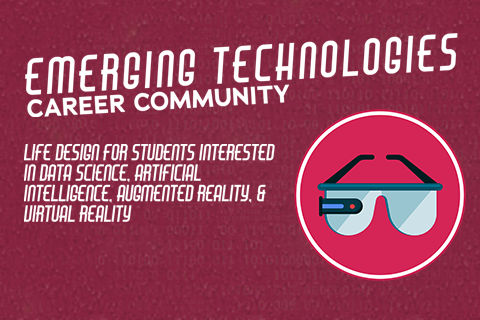Explore a career in Artificial Intelligence.
The theory and development of computer systems able to perform tasks that normally require human intelligence, such as visual perception, speech recognition, decision-making, and translation between languages.
-
Sample Industry Definitions, Job Titles & Project Areas
- Software Analyst – study an organization’s current computer systems and find a solution that is more efficient and effective
- Software Developer – create the applications or systems that run on a computer or another device.
- Computer Scientist – write and test code that allows computer applications and software programs to function properly
- Computer Engineer – design and develop solutions to complex applications problems, system administration issues, or network concerns. Perform systems management and integration functions
- Algorithm Specialists – performs research and designs algorithms for educational and real-world applications.
- Research Scientists – these individuals are experts in multiple AI disciplines, including applied mathematics, machine learning, deep learning, and computational statistics
- Engineering Consultant – usually work as part of a consulting company, and come into the field after receiving an engineering degree and have obtained several years of experience in their field. They are considered experts at whatever field of engineering they are involved in
- Big Data Engineer/Architect – play a vital role in developing an ecosystem that enables business systems to communicate with each other and collate data, most companies prefer professionals who have completed a Ph.D. in mathematics, computer science, or a related field
- Machine Learning Engineer- the heart of AI projects and is suitable for those who hail from a background in applied research and data science. However, it’s also necessary to be an AI programmer and demonstrate a thorough understanding of multiple programming languages
- Data Scientist – collects, analyzes, and interprets large, complex datasets by leveraging both machine learning and predictive analytics. They also play a vital role in developing algorithms that enable the collection and cleaning of data for analysis
- Business Intelligence Developer – the primary objective of this role is to analyze complex data sets to identify business and market trends
- Computer Vision Engineer – deals with how computers can be made to gain high-level understanding from digital images or videos; it seeks to automate tasks that the human visual system can do
- Data Curator – takes the organization of metadata to the next level and works with data dictionaries and data catalogs
- Data Evangelist – inspires businesses and individuals through interaction, content creation and communication about a technology
- AI Interaction Designer – the individual on the design, development, creative or marketing team that helps form and create a design strategy, identify key interactions of the product, create prototypes to test concepts and stay current on technology and trends that will impact users
-
Sample Project Areas
- Reactive Machines – purely reactive, and do not form memories or use past experiences to inform current decisions; this type of intelligence involved the computer perceiving the world directly and acting on what it sees
- Limited Memory – uses memory to learn and improve its responses; used in self-driving cars frequently as well as chatbots and virtual assistants
- Theory of Mind – understands the needs of other intelligent entitles
- Self-aware – has human-like intelligence and self-awareness
- Machine Vision System – type of technology that enables a computing device to inspect, evaluate and identify still or moving images
- Robotics – branch of technology that deals with the design, construction, operation, and application of robots
- Natural Language Processing – subfield of linguistics, computer science, information engineering and artificial intelligence concerned with interactions between computers and human (natural) languages, in particular how to program computers to process and analyze large amounts of natural language data
- Neural Network – computer system modeled on the human brain and nervous system
- Expert System – computer system that emulates the decision-making ability of a human expert
- Speech Recognition – interdisciplinary subfield of computational linguistics that develops methodologies and technologies that enables recognition and translation of spoken language into text by computers
- Genetic Programming – technique of evolving programs, starting from a population of unfit programs, fit for a particular task by applying operating analogous to natural genetic processes to the natural genetic processes to the population of programs
- (Computational) Linguistics – interdisciplinary field concerned with statistical or rule-based modeling of natural language from a computational perspective, as well as the study of appropriate computational approaches to linguistics questions
- Machine Learning – scientific study of algorithms and statistical models that computer systems use to perform a specific task without using explicit instructions, relying on patterns and inference instead
- Computer Vision – interdisciplinary scientific field that deals with how computers can be made to gain high-level understanding from digital images or videos; from the perspective of engineering, it seeks to automate tasks that the human visual system can do
- Human-robot Interaction – field of study dedicated to understanding, designing, and evaluating robotic systems for use by or with humans
- AI Research – there is a practical side concerned with building powerful software that re-creates some of the mind’s problem-solving abilities. Ad a theoretical side, where software and ideas from computing are used as tools to help understand the mind














